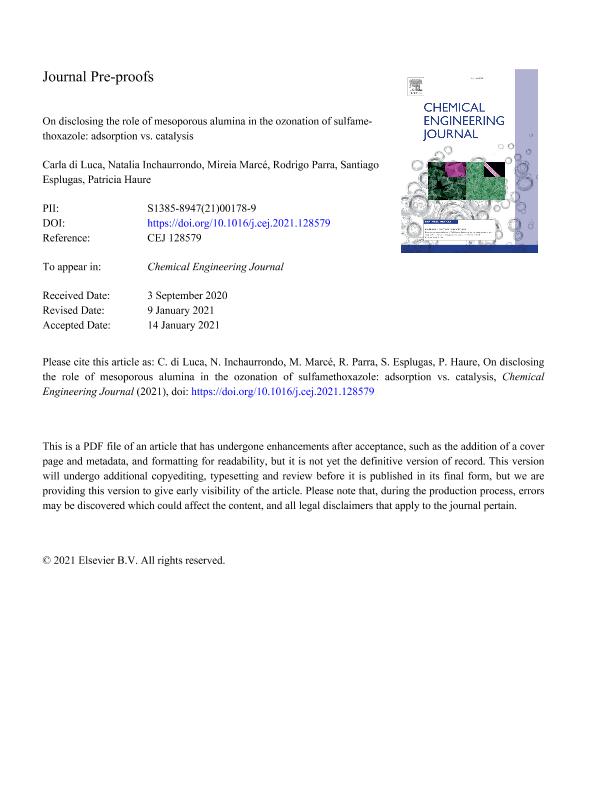Mostrar el registro sencillo del ítem
dc.contributor.author
Di Luca, Carla

dc.contributor.author
Inchaurrondo, Natalia Soledad

dc.contributor.author
Marcé, Mireia
dc.contributor.author
Parra, Rodrigo

dc.contributor.author
Esplugas, Santiago
dc.contributor.author
Haure, Patricia Monica

dc.date.available
2023-01-02T15:32:39Z
dc.date.issued
2021-05
dc.identifier.citation
Di Luca, Carla; Inchaurrondo, Natalia Soledad; Marcé, Mireia; Parra, Rodrigo; Esplugas, Santiago; et al.; On disclosing the role of mesoporous alumina in the ozonation of sulfamethoxazole: Adsorption vs. Catalysis; Elsevier Science; Chemical Engineering Journal; 412; 128579; 5-2021; 1-66
dc.identifier.issn
1385-8947
dc.identifier.uri
http://hdl.handle.net/11336/182901
dc.description.abstract
Ordered mesoporous alumina (MA) and Fe-doped MA were synthesized by evaporation-induced self-assembly and tested for the ozonation of sulfamethoxazole (SMX). The synthesis methodology produced MA whose surface and structural properties exceeded those of commercial types displaying a BET surface area of 263 m2/g, a pore volume of 0.8 cm3/g and aligned cylindrical pores of c.a. 10 nm. The ozonation of SMX (20 mg/L) was performed in a semibatch stirred tank reactor at: T = 22 °C, [O3]gas = 10 mg/L, Qgas = 42 L/h NTP, [solid] ≈ 1 g/L, t = 120 min. Single ozonation achieved fast and complete SMX removal and mineralized up to 35% of the organics at neutral pH. The addition of MA or Fe-doped MA did not affect the removal rate of SMX, but did achieve a remarkable TOC removal up to 86% at acid pH. However, under the selected operating conditions, ferric species did not improve the removal of organic matter. Then, the adsorption and catalytic contribution of MA was evaluated in specifically-designed experiments. While SMX adsorption was low, its oxidation intermediates did adsorb onto MA surface. Despite the high ability of the materials to decompose ozone, the results revealed that the by-products adsorption is the prevailing process for the TOC removal. After four successive reuses, MA reduced its adsorption performance due to chemisorption of carboxylates. Nevertheless, the worn material was regenerated by direct ozonation in gas phase. In addition, primary transformation products were identified by LC–ESI–TOF–MS and the scavenging effect of the water matrix was assessed using bottled water and a real secondary wastewater.
dc.format
application/pdf
dc.language.iso
eng
dc.publisher
Elsevier Science

dc.rights
info:eu-repo/semantics/openAccess
dc.rights.uri
https://creativecommons.org/licenses/by-nc-nd/2.5/ar/
dc.subject
OZONIZACIÓN
dc.subject
ALÚMINA MESOPOROSA ORDENDA
dc.subject
CONTAMINANTES EMERGENTES
dc.subject
ADSORCIÓN
dc.subject.classification
Otras Ingeniería Química

dc.subject.classification
Ingeniería Química

dc.subject.classification
INGENIERÍAS Y TECNOLOGÍAS

dc.title
On disclosing the role of mesoporous alumina in the ozonation of sulfamethoxazole: Adsorption vs. Catalysis
dc.type
info:eu-repo/semantics/article
dc.type
info:ar-repo/semantics/artículo
dc.type
info:eu-repo/semantics/publishedVersion
dc.date.updated
2022-09-20T18:48:23Z
dc.journal.volume
412
dc.journal.number
128579
dc.journal.pagination
1-66
dc.journal.pais
Países Bajos

dc.journal.ciudad
Amsterdam
dc.description.fil
Fil: Di Luca, Carla. Consejo Nacional de Investigaciones Científicas y Técnicas. Centro Científico Tecnológico Conicet - Mar del Plata. Instituto de Investigaciones en Ciencia y Tecnología de Materiales. Universidad Nacional de Mar del Plata. Facultad de Ingeniería. Instituto de Investigaciones en Ciencia y Tecnología de Materiales; Argentina. Universidad Nacional de Mar del Plata. Facultad de Ingeniería. Departamento de Ingeniería Química; Argentina
dc.description.fil
Fil: Inchaurrondo, Natalia Soledad. Consejo Nacional de Investigaciones Científicas y Técnicas. Centro Científico Tecnológico Conicet - Mar del Plata. Instituto de Investigaciones en Ciencia y Tecnología de Materiales. Universidad Nacional de Mar del Plata. Facultad de Ingeniería. Instituto de Investigaciones en Ciencia y Tecnología de Materiales; Argentina. Universidad Nacional de Mar del Plata. Facultad de Ingeniería. Departamento de Ingeniería Química; Argentina
dc.description.fil
Fil: Marcé, Mireia. Universidad Central de Barcelona; España
dc.description.fil
Fil: Parra, Rodrigo. Consejo Nacional de Investigaciones Científicas y Técnicas. Centro Científico Tecnológico Conicet - Mar del Plata. Instituto de Investigaciones en Ciencia y Tecnología de Materiales. Universidad Nacional de Mar del Plata. Facultad de Ingeniería. Instituto de Investigaciones en Ciencia y Tecnología de Materiales; Argentina
dc.description.fil
Fil: Esplugas, Santiago. Universidad Central de Barcelona; España
dc.description.fil
Fil: Haure, Patricia Monica. Consejo Nacional de Investigaciones Científicas y Técnicas. Centro Científico Tecnológico Conicet - Mar del Plata. Instituto de Investigaciones en Ciencia y Tecnología de Materiales. Universidad Nacional de Mar del Plata. Facultad de Ingeniería. Instituto de Investigaciones en Ciencia y Tecnología de Materiales; Argentina. Universidad Nacional de Mar del Plata. Facultad de Ingeniería. Departamento de Ingeniería Química; Argentina
dc.journal.title
Chemical Engineering Journal

dc.relation.alternativeid
info:eu-repo/semantics/altIdentifier/url/https://www.sciencedirect.com/science/article/pii/S1385894721001789
dc.relation.alternativeid
info:eu-repo/semantics/altIdentifier/doi/https://doi.org/10.1016/j.cej.2021.128579
Archivos asociados
